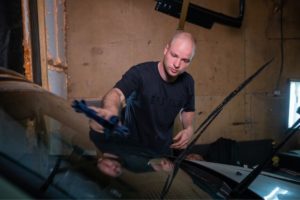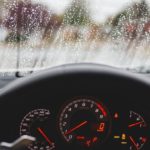Quick Navigation
Have you ever heard a sloshing sound coming from your car when you accelerate? If so, it’s important to take action and find out the cause of this noise.

There are several potential causes for water in your car, and it’s essential to understand why and what to do about it.
Let’s explore the possible causes of water in your car and how to remedy the problem.
What Causes Sloshing During Acceleration?
If you hear water in your car when accelerating, that’s a common problem vehicle owners face. Multiple reasons can cause it.
Here are the most common causes of sloshing during acceleration and how to fix them.
1. Clogged Evaporator Drain
If the drain on your air conditioning system is blocked or not operating correctly, a sloshing sound can be heard when driving.
You will mostly hear water in your car when turning corners or braking.
This water build-up may also result in mold growth and release musty odors, which could cause allergies.
You must clear away any blockages to restore this vital component’s functionality.
Cleaning a clogged evaporator drain can be a simple process if you have the right tools and follow these steps:
- Locate the evaporator drain: The evaporator drain is found close to the firewall in your vehicle’s engine bay. This small tube works diligently to get rid of any moisture from the air conditioning unit.
- Check the drain line: Before starting any evaporator drain cleaning, make sure there are no obstructions in the drainage line. To ensure this is done correctly, remove the pipe and look for anything that may be hindering normal flow.
- Clean the drain pan: Be sure to remove the drain pan and remove any lingering water. Utilize a cloth or rag to wipe away any dirt or gunk from the bottom of the drain pan for optimal cleanliness.
- Clean the evaporator drain: To unblock your evaporator drains and eliminate any debris, try using a long, narrow tool like a coat hanger or flexible cleaning device. Additionally, you can also apply water and vinegar in equal parts to help remove even the most stubborn clogs.
- Reinstall the drain line: Securely reattach the evaporator drain line after cleaning to ensure there are no leaks.
- Test the system: After starting your vehicle and turning up the air conditioning, check to ensure that water drains correctly from the evaporator drain. You shouldn’t hear water in your car when accelerating now. If this is true, you can rejoice in knowing that you have successfully cleared any blockage!

2. Low Coolant
Have you heard water in your car while accelerating, coming from behind your dashboard while the engine is running?
This could be due to low levels of coolant/antifreeze used in most vehicles’ heating systems that run through the heater core.
When there isn’t enough coolant, air bubbles often form, leading to this noise.
Fortunately, it’s simple to fix! Just check and fill up your car’s coolant level with a fluid according to manufacturer recommendations.
If you notice that it begins declining again shortly afterward, however, there may be an issue with a leak within your cooling system.
3. Air in the Coolant System
Despite a normal coolant level, air pockets can form in the cooling system due to leaks, such as a faulty radiator cap.
This usually results in hearing water in the car when accelerating. In this case, it’s caused by the heater core when you start or idle your engine.
To prevent potential damage to your car’s motor, you must bleed any trapped air out of the cooling system.
Bleeding air from the coolant system is a process that helps to remove any trapped air pockets in the system that can cause overheating and reduced performance.
Here is how to do it:
- Locate the bleeder valve: The highest point of the coolant system, typically near the thermostat housing, is usually where you’ll find the bleeder valve.
- Make sure the engine is cool: Before beginning, it is essential to ensure the engine has cooled off as the coolant will be under strain if the engine remains hot.
- Prepare a catch container: Position a funnel beneath the bleeder valve to collect any spilled coolant.
- Open the bleeder valve: Taking a wrench or pliers in hand, carefully open the bleeder valve. Sit back and watch as coolant flows out while the air escapes accordingly.
- Check the coolant level in the radiator: To keep the system running smoothly, frequently check to ensure that your radiator’s coolant level doesn’t drop as air escapes. If it does, top off the tank with additional coolant right away!
- Repeat the process: Keep operating the bleeder valve until you no longer sense air leaking and only coolant is exiting from it.
- Close the bleeder valve: Once you’ve ensured that every ounce of air has been expelled from the mechanism, firmly close the bleeder valve with a wrench or pliers.
- Check for leaks: Ensure the coolant amount in the radiator is adequate and inspect for any escaping liquid from the system.
- Start the engine: Ignite your engine and let it run for a few minutes to ensure that the coolant is sufficiently circulated. Verify that everything is in check by inspecting the temperature gauge to determine if your car is running at its ideal operating temperature.
4. Clogged Door Drain
When it rains, or your car goes through a wash, water can make its way into the doors via window seals. It mostly flows out of drain holes located at the bottom.
If these drains aren’t regularly cleaned, dirt and debris will build up over time, preventing proper drainage.
This could lead to sloshing sounds that are heard when driving, especially during acceleration/deceleration.
To check if this is an issue with your vehicle, sway each door back and forth quickly.
Compressed air or flexible wire should be used to unclog any blockages you come across!
Try to do the following:
If the door drains in your vehicle is clogged, you can follow these steps to unclog it:
- Locate the drain: Door drains are typically situated near the bottom of the door, close to its outermost edge.
- Gather tools: To complete this task, you’ll require a flashlight for illumination, some stiff wire or a coat hanger to maneuver the space around your appliance, and lastly a towel or rag in case any water spills.
- Open the door: For optimum drain access, be sure to open the door.
- Clear any debris: Illuminate the drain with your flashlight, and use a stiff wire to clear away any obstructions, such as leaves or dirt.
- Flush the drain: After eliminating the debris, flush the drain with water to determine whether it has been opened up.
- Use a vacuum: If the water isn’t flowing, a vacuum can be your best friend in clearing out any blockages.
- Try using compressed air: If your drain is still clogged, compressed air can be used to blast away any obstructions and clear the pipe.

Clogged Windshield Drain
Blocked windshield drains in the cowl/firewall location can create sloshing or splashing sounds from within your vehicle or behind its dashboard while it is moving.
Excessive water buildup will cause leakage into the passenger compartment, resulting in musty odors and potentially serious fungal growth on upholstery and carpets.
To clear these clogs, compressed air, and a flexible wire are excellent solutions to ensure no further issues arise. Just follow these steps:
1. Locate the Windshield Drain
Search near the bottom of your windshield’s firewall or cowl area to locate the small but mighty windshield drain.
You may have a hard time noticing it, so make sure you look closely!
2. Clean the Drain Area
To ensure you have effortless access to the drain holes, any dirt, debris, or leaves in and around those areas must be swept away.
3. Use Compressed Air to Unclog the Drain
Unclogging your windshield drain has never been easier – just use compressed air! You must insert the nozzle into the clogged hole and blow in some compressed air.
The pressure should easily blast away any blockages, freeing up your drainage system.
4. Use a Flexible Wire to Unclog the Drain
If you lack access to compressed air, then a flexible wire is the ideal solution for unclogging your drain.
Inserting it into the hole and giving it a few good wiggles can help break up any dirt or grime lodged in there.
5. Clean the Drain Area after Unclogging
After clearing your drain, be sure to completely remove any dirt or debris that may have been dislodged. Once you’ve done so, don’t forget to clean the area thoroughly!
6. Check for Leaks
Finally, it’s time to test the drain out.
Simply pour some water over your windshield and check for any leaks – if there are none, then it means that the clog has been cleared successfully and your drains are functioning as they should!
Conclusion
When your car makes a splashing noise during acceleration, it may be due to any of the following: a clogged evaporator drain, low coolant levels, air pockets in the cooling system, or blocked door drains.
To ensure that this does not lead to further damage and enhance the driving experience, quickly identify what’s causing the sloshing sound and take immediate steps for repair.

With comprehensive experience in writing exceptional quality articles and blogs about cars and related stuff, Daniel is one of the finest bloggers and a hardcore car lover we have. He is an ASE certified technician with an across-the-board experience of 10 years in the industry. He could not help tinkering with anything he got his hands on from a young age, which led to his remarkable career in the automotive repair industry.
When he is not under any hood, you can find him on the water or in the woods to pursue his passion for hunting and fishing. He has been writing for multiple sectors and is a regular contributor to several publications.
He currently owns a Nissan 300ZX TT and a Pearl Yellow but plans to upgrade it to 550 HP. His favorites include the Koenigsegg CCX and Lamborghini Diablo 6.0 VT, but for him, the Ferrari 360 Spider is one of the sexiest cars that exists to date.
Being an avid world traveler, he has spent most of his time analyzing the automotive markets, latest technology, and local favorites to enhance his knowledge base. He is currently living in North Caroline, where it’s all about food and coffee and, of course, cars.







